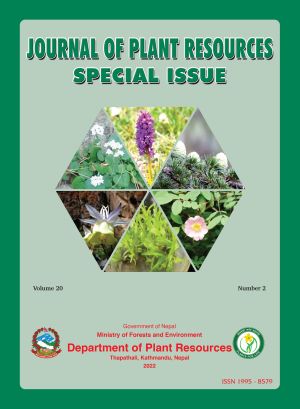In-vitro Propagation of Dendrobium chryseum Rolfe
DOI:
https://doi.org/10.3126/bdpr.v20i2.57024Keywords:
Ex situ conservation, MS medium, Orchid, Plant growth regulators, ProtocormsAbstract
Dendrobium chryseum is an endangered epiphytic and lithophytic orchid species having medicinal and ornamental value. The objective of the present study is to develop micropropagation protocol for D. chryseum. The immature seeds of D. chryseum were used as an explant for the micropropagation. Protocorms were developed within 90 days in Murashige and Skoog (MS) medium without plant growth regulators. Protocorms were differentiated into micro shoots after 30 days of transfer to MS medium supplemented with 2 mg/L Benzyl amino purine (BAP), 1 mg/L kinetin and 10% coconut water. Among eleven different combinations of plant growth regulators (BAP, á-Naphthalene acetic acid (NAA), Adenine sulphate, Kinetin and coconut water) treated for shoot multiplication, maximum number of shoots were obtained in 0.5 mg/L BAP + 0.5 mg/L NAA (5.8 ± 0.53 SE shoots per explant). Longest shoot length was recorded in MS medium with Adenine sulphate (1 mg/L) (2.54 ± 0.03 cm SE). Root induction was carried out by using MS medium with different concentrations (0.5, 1, 1.5, 2.0 mg/L) of Indole butyric acid (IBA) and NAA. The highest numbers of roots and longest root length, both were observed at 2 mg/L IBA (4.63 ± 0.56 SE and 2.09 ± 0.25 cm SE respectively). 2 mg/L NAA showed poor response for root number (0.94 ± 0.21 SE) and root length (0.43 ± 0.07 cm SE). Successful acclimatization of in-vitro grown plantlets was done by wrapping the plantlet with moss kept on fine pine bark and the survival rate of plantlet was about 80% after 30 days. This protocol could be helpful for the effective mass propagation and ex situ conservation of D. chryseum.




